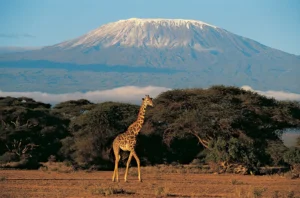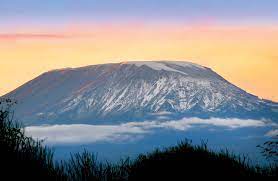Mount Kilimanjaro is a majestic stratovolcano located in Tanzania, East Africa, and is the highest peak on the African continent,
standing at an impressive 5,895 meters (19,341 feet) above sea level. It is one of the most iconic and sought-after destinations
for trekkers and adventure enthusiasts worldwide. Mount Kilimanjaro serves as an important site for scientific research and exploration. Scientists from various disciplines, including geology, ecology, climatology, and glaciology, study the mountain to better
understand its geological history, ecological dynamics, and the impacts of climate change.
Click here to watch a video on how to climb the mountain: https://www.youtube.com/watch?v=XRwrpXf5V6c
A Glimpse
Mount Kilimanjaro is a dormant volcano comprising three volcanic cones: Kibo, Mawenzi, and Shira. Its peak, Uhuru Peak, is
located on the Kibo cone and is the highest point on the mountain. Kilimanjaro is unique in that it rises from the surrounding plains,
creating a stunning and dramatic landscape.
The Mountain’s glaciers have been receding at an alarming rate over the past century, with some estimates suggesting that they could disappear entirely within a few decades. Researchers study the dynamics of glacial retreat to assess its implications for water resources, biodiversity, and local communities reliant on meltwater from the mountain.
Researchers also investigate the cultural heritage associated with Mount Kilimanjaro, documenting indigenous knowledge, traditional land use practices, and archaeological sites to promote cultural preservation and heritage conservation efforts.
Although Mount Kilimanjaro is currently dormant, ongoing research helps monitor seismic activity and volcanic gas emissions to assess potential volcanic hazards and inform risk mitigation strategies for nearby communities.
Mount Kilimanjaro and its surrounding ecosystems face various environmental challenges, including deforestation, habitat loss,
and the impacts of climate change. Conservation efforts are underway to protect the mountain’s biodiversity and preserve its
natural beauty for future generations. Sustainable tourism practices, responsible trekking guidelines, and community-based
initiatives play a crucial role in ensuring the long-term preservation of Kilimanjaro’s ecological integrity.


Amazing structure of the Mountain
Ecological Diversity
The mountain’s diverse ecosystems are a result of its varying altitudes and climatic conditions. Kilimanjaro is home to five
distinct ecological zones, including cultivated land, rainforest, heath, moorland, and alpine desert. Each zone is characterized
by its unique flora and fauna, offering trekkers a remarkable journey through different landscapes.
Trekking and Climbing
Trekking to the summit of Mount Kilimanjaro is a bucket-list adventure for many outdoor enthusiasts. There are several
established routes to choose from, each offering a unique experience in terms of scenery, difficulty, and duration. Popular routes include the Marangu, Machame, Lemosho, and Rongai routes, with varying degrees of difficulty and success rates.
The diverse ecosystems of Mount Kilimanjaro support a rich array of plant and animal species, some of which are endemic to the region. Scientists conduct biodiversity surveys and ecological studies to document species distributions, population dynamics, and the effects of environmental changes on wildlife habitats.
Challenges and Preparations
While Kilimanjaro is not a technical climb, reaching its summit is still a challenging endeavor due to factors such as high altitude, low oxygen levels, and unpredictable weather conditions. Proper preparation, including physical training, acclimatization, and packing appropriate gear, is essential for a successful ascent.
Uhuru Peak
Standing atop Uhuru Peak, the highest point on Kilimanjaro, is a moment of triumph and exhilaration for trekkers. The panoramic views from the summit, encompassing the surrounding plains and distant horizons, are nothing short of breathtaking. Watching the sunrise from Uhuru Peak is a particularly awe-inspiring experience, as the first light of dawn illuminates the vast African landscape below.
By advancing our understanding of Mount Kilimanjaro’s natural and cultural heritage, scientific research contributes to informed decision-making, sustainable management practices, and conservation initiatives aimed at protecting this iconic mountain for future generations.
Adventures Experience
Mount Kilimanjaro stands as a majestic testament to nature’s grandeur, challenging adventurers with its towering heights and
awe-inspiring landscapes. Scaling its peaks offers not just a physical journey, but a profound mental and spiritual experience, pushing boundaries and revealing the depths of one’s resilience. From the lush rainforests to the barren alpine desert and the icy summit,
every step unveils a new facet of this iconic mountain, leaving an indelible mark on the souls of those brave enough to conquer it. As an adventurer, standing atop Kilimanjaro’s Uhuru Peak is not just a triumph of endurance, but a celebration of the human spirit’s boundless capacity for exploration and discovery
As an adventurous soul, Mount Kilimanjaro beckons with its irresistible allure, promising the ultimate test of strength, endurance,
and fortitude. Conquering its towering heights is not merely a physical conquest, but a journey of self-discovery and personal triumph. From navigating through dense forests teeming with life to braving the icy winds at the summit, each step forward is a testament to the
unyielding spirit of adventure that drives us to push beyond our limits. Standing atop Kilimanjaro’s majestic peak, surrounded by a panorama of clouds and endless vistas, one is filled with a sense of exhilaration and accomplishment that can only be earned through daring exploration and fearless pursuit of the unknown. Mount Kilimanjaro is more than just a mountain; it is a beacon calling upon the adventurous to leave their mark upon its storied slopes and forge memories that will last a lifetime.
Read More: https://placesandlifestyle.com/the-cultural-and-architectural-significance-of-ibadan-bowers-tower/




